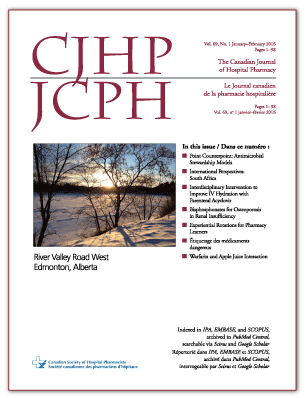Interdisciplinary Systems-Based Intervention to Improve IV Hydration during Parenteral Administration of Acyclovir
DOI:
https://doi.org/10.4212/cjhp.v69i1.1517Keywords:
acyclovir, patient safety, acute kidney insufficiency, medication errors, sécurité des patients, insuffisance rénale aiguë, erreurs de médicamentAbstract
ABSTRACT
Background: Intravenous (IV) hydration is considered a protective factor in reducing the incidence of acyclovir- induced nephrotoxicity. A systems based review of cases of acyclovir-associated acute kidney injury can be used to examine institution-, care provider-, and task-related factors involved in administering the drug and can serve as a basis for developing a quality improvement intervention to achieve safer administration of acyclovir.
Objectives: To explore the effectiveness of the study institution’s inter - disciplinary quality improvement intervention in increasing the dilution of acyclovir before IV administration.
Methods: After conducting a systems-based review for intervention development, a retrospective analysis was undertaken to compare IV administration of acyclovir in the 6-month periods before and after implementation of the intervention. The study population was a sequential sample of all patients over 18 years of age who were seen in the emergency department or admitted to a ward and who received at least one IV dose of acyclovir at the study institution. The primary outcome was the volume in which each acyclovir dose was delivered. The secondary outcomes were the hourly rate of fluid administration, the frequency of an increase in hourly hydration rate, and the incidence of acute kidney injury.
Results: Eighty-four patients (44 in the pre-intervention period and 40 in the post-intervention period) received IV acyclovir and had evaluable data for the primary outcome. The median volume in which the acyclovir dose was administered was significantly higher in the post-intervention group (250 mL versus 100 mL, p < 0.001).
Conclusions: In this study, an easily implemented intervention significantly increased the volume of IV fluid administered to patients receiving acyclovir. Adequately powered prospective studies are suggested to investigate the effectiveness of this intervention on the clinically relevant incidence of acyclovir-induced nephrotoxicity.
RÉSUMÉ
Contexte : L’hydratation par voie intraveineuse est considérée comme un facteur de protection aidant à réduire l’incidence des cas de néphrotoxicité associés à l’acyclovir. Une analyse de systèmes des cas d’insuffisance rénale aiguë associés à l’acyclovir peut servir à examiner les facteurs liés aux établissements, aux fournisseurs de soins et aux tâches qui touchent l’administration du médicament et à générer ainsi une mesure visant l’amélioration de la qualité qui rendra l’administration d’acyclovir plus sûre.
Objectif : Étudier l’efficacité de la mesure interdisciplinaire visant l’amélioration de la qualité qui a été mise en oeuvre dans l’établissement de l’étude et qui encourageait à diluer davantage l’acyclovir avant son administration par voie intraveineuse.
Méthodes : Après avoir procédé à une analyse de systèmes pour générer une mesure d’intervention, une analyse rétrospective a été réalisée afin de comparer l’administration d’acyclovir par voie intraveineuse au cours des six mois précédant et suivant la mise en oeuvre de la mesure. La population de l’étude était composée d’un échantillon progressif de tous les patients de plus de 18 ans ayant séjourné aux urgences ou dans un service intra-hospitalier et ayant reçu au moins une dose d’acyclovir par voie intraveineuse dans l’établissement concerné. Le principal parameter d’évaluation était le volume de liquide contenant chaque dose d’acyclovir administrée. Les paramètres d’évaluation secondaires comprenaient : le débit horaire de liquide administré, la fréquence d’ajustement à la hausse du débit liquidien horaire et la fréquence des cas d’insuffisance rénale aiguë.
Résultats : Quatre-vingt-quatre patients (44 dans la période précédant l’application de la mesure et 40 dans la période la suivant) ont reçu de l’acyclovir par voie intraveineuse et présentaient des données évaluables pour le paramètre principal. Le volume médian avec lequel chaque dose d’acyclovir était administrée était significativement supérieur dans le groupe suivant l’application de la mesure (250 mL contre 100 mL, p < 0,001).
Conclusions : Cette étude montre qu’une mesure facile à mettre en place augmentait de façon significative le volume de liquides intraveineux administré aux patients recevant de l’acyclovir. L’on suggère de réaliser des études prospectives d’une puissance suffisante pour évaluer l’efficacité de cette mesure en ce qui a trait à la fréquence cliniquement significative des cas de néphrotoxicité associés à l’acyclovir.
Downloads
Published
Issue
Section
License
Copyright © Canadian Society of Healthcare-Systems Pharmacy.
After publication of a manuscript in the CJHP, the authors of the manuscript must obtain written permission from the CSHP (publications@cshp.ca) before reproducing any text, figures, tables, or illustrations from the work in future works of their own. If a submitted manuscript is declined for publication in the CJHP, all said rights shall revert to the authors. Please note that any forms (e.g., preprinted orders and patient intake forms) used by a specific hospital or other health care facility and included as illustrative material with a manuscript are exempt from this copyright transfer. The CJHP will require a letter from the hospital or health care facility granting permission to publish the document(s).










